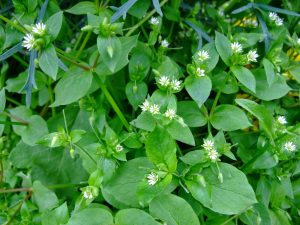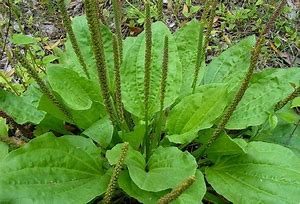Yes, that’s right there actually is food growing all around us! Some may refer to them as weeds but if only they knew how nutritious and yummy these wild foods are. This article will introduce you to a few of the most common wild foods growing in New Brunswick however there are many more to discover! Before consuming any plant make sure you have properly identified it using a plant ID book or take an herb walk with your local herbalist.
Dandelion (Taraxacum officinale)
Dandelion leaves are super nutritious and they should be eaten as often as possible. Dandelion leaves have long been considered a spring tonic. When young and fresh, the leaves have a delicate bitter taste that stimulates digestion. Dandelion flowers are high in lutein, a constituent known to dramatically support eye health. They have a surprisingly sweet and mild flavor. They can be added to your salad! A cup of dandelion flower tea with a little honey can help to relieve and heal headaches, menstrual cramps, backaches, stomach aches, and even depression.
Dandelion roots and leaves are abundant in rich amounts of usable minerals such as calcium, iron, copper, magnesium, manganese, phosphorus, potassium, selenium, silicon, and zinc. They are also an excellent source of vitamin A, the B complex vitamins, C, and D. They supply beneficial carotinoids, fatty acids, flavonoids, and phytosterols. Dandelion roots and leaves contain high amounts of potassium. Dandelion leaves have three times more calcium, iron and Vitamin A than spinach! The leaves are 19-32% protein. Dandelion greens are high in fiber, which helps your body shed waste.
Plantain (Plantago major)
Broadleaf plantain is also a highly nutritious wild edible, that is high in calcium and vitamins A, C, and K. The young, tender leaves can be eaten raw, and the older, stringier leaves can be boiled in stews and eaten. The leaves are edible as a salad green when young and tender, but they quickly become tough and fibrous as they get older. The older leaves can be cooked in stews. Due to its astringent properties, a tea of plantain leaves can be ingested to treat diarrhea. Due to the high vitamin and mineral content, plantain tea simultaneously replenishes the nutrients lost because of diarrhea. Adding fresh plantain seeds or flower heads to a tea will act as an effective lubricating and bulking laxative and soothe raw, sore throats.

Violet (Viola tricolor)
Violet leaves and flowers are highly nutritious in vitamins A and C, and high in antioxidants. During cold and flu season, the high vitamin C content will give a virus-preventative boost to the immune system. After gathering the leaves, either eat them raw in salads with an herby vinaigrette, or cook them like spinach in a little water with butter, adding salt and pepper to taste. Serve the cooked violet greens with the residual liquid to preserve the vitamins. Violets have been used to improve acne, anger, asthma, bronchitis, colds, eczema, fever, fibrocystic breast disease, grief, headache, heartbreak, lymphatic congestion, mastitis, mumps, psoriasis, scurvy, sore throat, ulcers, urinary tract infection, varicose veins, and whooping cough. Apply a cloth soaked in violet leaf and/or flower tea to the back of the neck to treat headaches. The flowers are eaten as a breath freshener.

Chickweed (Stellaria media)
Fresh chickweed contains high amounts of vitamin C, as well as vitamins A, D and B. Iron, calcium and potassium can also be found in chickweed. Chickweed leaves can be steamed or added raw to salads. You can also make a tea from the leaves by steeping them in a cup of boiling water for ten minutes. Chickweed can soothe mucus membranes and help relieve many respiratory conditions, including asthma, allergies and bronchitis, as well as itchy, inflamed eyes. Chickweed’s soothing properties also extend to skin care. Chickweed can soothe inflamed and irritated skin conditions such as acne, eczema, rashes and burns, as well as heal cuts.
WILD FOOD RECIPES
Dandelion Lemonade
You’ll need about 2 quarts of flowers to make a gallon of lemonade.
Bring the flowers inside and place them in a gallon jar. Fill the jar with room temperature water and add the juice of 4 lemons. Add fresh honey to taste, and chill. You can strain the flowers out after a few hours or just leave them to fall into the glasses when you serve the lemonade.
Dandelion Pumpkin Seed Pesto
3/4 cup unsalted hulled (green) pumpkin seeds 3 garlic gloves, minced
1 tablespoon lemon juice 1/2 cup extra-virgin olive oil
1/2 teaspoon kosher salt Black pepper, to tasted
1 bunch dandelion greens (about 2 cups, loosely packed)
1/4 cup freshly grated parmesan (substitute with nutritional yeast)
Preheat the oven to 350°F. Pour the pumpkin seeds onto a shallow-rimmed baking sheet and roast until just fragrant, about 5 minutes. Remove from the oven and allow to cool. Pulse the garlic and pumpkin seeds together in the bowl of a food processor until very finely chopped. Add parmesan cheese (nutritional yeast), dandelion greens, and lemon juice and process continuously until combined. Stop the processor every now and again to scrape down the sides of the bowl. The pesto will be very thick and difficult to process after awhile —that’s ok. With the blade running, slowly pour in the olive oil and process until the pesto is smooth. Add salt and pepper to taste
Wild Weed Dressing
½ cup apple cider vinegar or herbal infused vinegar 1 tbsp. nutritional yeas
t3 cloves garlic
2 tbsp. hemp seeds 1 cup olive and/or hemp oil
2 tbsp. tamari 2 tbsp. tahini
2 cups wild greens (sorrel leaves, plantain, wild onion chives, dandelion leaves, violet leaves, chickweed, lamb’s quarters, etc)
Combine ingredients in a blender and blend till smooth. Drizzle over your summer salad greens.
Store in a bottle or jar, and refrigerate. It will last for a few weeks in the fridge. Makes 2 cups
Marinated Dandelion Greens
This recipe requires no cooking, making it a great way to get your greens during the busy spring
and summer months.
1 bunch Dandelion Greens, chopped Olive Oil Apple Cider Vinegar 1 clove Garlic, crushed and
chopped (optional)
Clean your dandelion greens thoroughly and chop. Place greens in a bowl, drizzle on the olive oil
and apple cider vinegar, and stir. If you need an immune boost or vampire protection, crush a
clove of garlic, letting it oxidize for a couple minutes (to get its full medicinal benefits), finely chop,
and stir in with the greens. Cover your bowl and leave it to marinate for a few hours or overnight.
And there you go, your greens are ready! If you don’t eat them all right away, store them in the
fridge.
Dandelion Pumpkin Seed Pesto
Makes about 1 cup
3/4 cup unsalted hulled (green) pumpkin seeds 3 garlic gloves, minced
1/4 cup freshly grated parmesan (substitute with nutritional yeast) 1 tablespoon lemon juice
1 bunch dandelion greens (about 2 cups, loosely packed) 1/2 teaspoon kosher salt
1/2 cup extra-virgin olive oil Black pepper, to taste
Preheat the oven to 350°F. Pour the pumpkin seeds onto a shallow-rimmed baking sheet and
roast until just fragrant, about 5 minutes. Remove from the oven and allow to cool.
Pulse the garlic and pumpkin seeds together in the bowl of a food processor until very finely
chopped.
Add parmesan cheese (nutritional yeast), dandelion greens, and lemon juice and process
continuously until combined. Stop the processor every now and again to scrape down the sides of
the bowl.
The pesto will be very thick and difficult to process after awhile —that’s ok. With the blade running,
slowly pour in the olive oil and process until the pesto is smooth. Add salt and pepper to taste.
Dandelion Wine a la Laughing Rock (Susun Weed recipe)
8 liter crock 3-5 liters blossoms
5 quarts water 1.5 kg sugar
1 organic lemon 1 organic orange
1 pkg live yeast whole wheat bread/toast
Find a field of dandelions in bloom on a glorious shining day. Follow the honey bees to the finest
flowers. Leave the green sepals on, but get rid of all stalks. Put blossoms immediately into a large
ceramic, glass, or plastic vessel. Boil water, pour over flowers. Cover your crock with cheesecloth.
Stir daily for three days. On the fourth day, strain blossoms from liquid. Cook liquid with sugar
and rind of citrus for 30-60 minutes. Return to crock. Add citrus juice. When liquid has cooled
to blood temperature, soften yeast, spread on toast, and float toast in crock. Cover and let work
for two days. Strain. Return liquid to crock for one more day to settle. Filter into very clean
bottles and cork lightly. Don’t drink until winter solstice.
Violet-Mint Salad
2 cups Violet leaves, cut into thin ribbons 1 carrot, grated
1 cup Mint leaves, chopped fine or minced in food processor 1 cup walnuts
1 cup dried fruit (choice of raisins, dates, craisins, currants, apricot) 1 cup Violet blossoms
Toss everything together and top with your favorite dressing.
Creamy Violet Dressing
½ cup olive oil 1 Tbsp lemon juice (or vinegar)
1 tsp honey 2 cups fresh Violet greens
¼ tsp salt 1 garlic clove
dash of pepper ½ cup yoghurt
In blender or food processor, blend all ingredients but the yoghurt thoroughly. Add yoghurt, and blend
gently until smooth.
Chickweed Pakoras
100g gram (chickpea) flour 1 tbsp medium curry powder, or to taste
½ tsp baking powder ½ tsp sea salt (or more)
About 120ml water 50g chickweed, washed, dried and roughly chopped
1 small onion 1 ordinary garlic clove, peeled and finely chopped
Vegetable oil for shallow-frying
Mix the flour, curry powder, baking powder and salt together in a bowl, then slowly stir in enough water to
form a paste the consistency of mustard. Mix in the chickweed and crow garlic and stir until they are well
coated in the paste. Heat a thin layer of oil in a heavy-based frying pan. When hot, spoon in heaped dessert
spoonfuls of the pakora mixture to form little cakes, spacing them well apart. Cover with a lid and cook
over a medium heat for about 5 minutes until crisp and golden brown on one side. Turn the cakes over to
brown the other side. Drain on kitchen paper and serve at once.
Chickweed Soup
1 Medium onion 2 Small potatoes
1 Litre of chicken or vegetable stock Water
A good knob of butter and some olive oil Salt and Black pepper
2 Good handfuls of chickweed, only use fresh green growth which has not flowered.
Peel and finely dice the onion and potatoes. Remove big stalks from the chickweed and wash well
Melt the butter in some olive oil in a large saucepan. Saute the onion until soft and golden but do not let it
burn. Add the diced potatoes and stir in the oil for a couple of minutes. Add a little water, enough to cover
the potatoes and simmer until the potatoes are soft. Then add the chicken stock and cook until it is boiling.
Throw in the chickweed leaves and simmer for about ten minutes. Season with salt and pepper. Remove
pan from the heat and use a hand blender to blend the soup.


 On our magical land, we use permaculture and biodynamic practices to consciously influence the life processes in nature so that harmonious and healing forces will be present in the medicinal herbs we grow and wild-craft.
On our magical land, we use permaculture and biodynamic practices to consciously influence the life processes in nature so that harmonious and healing forces will be present in the medicinal herbs we grow and wild-craft.